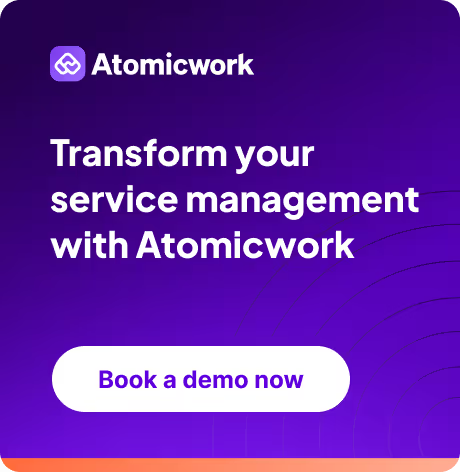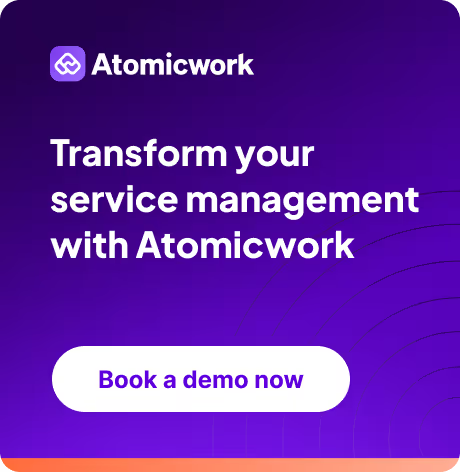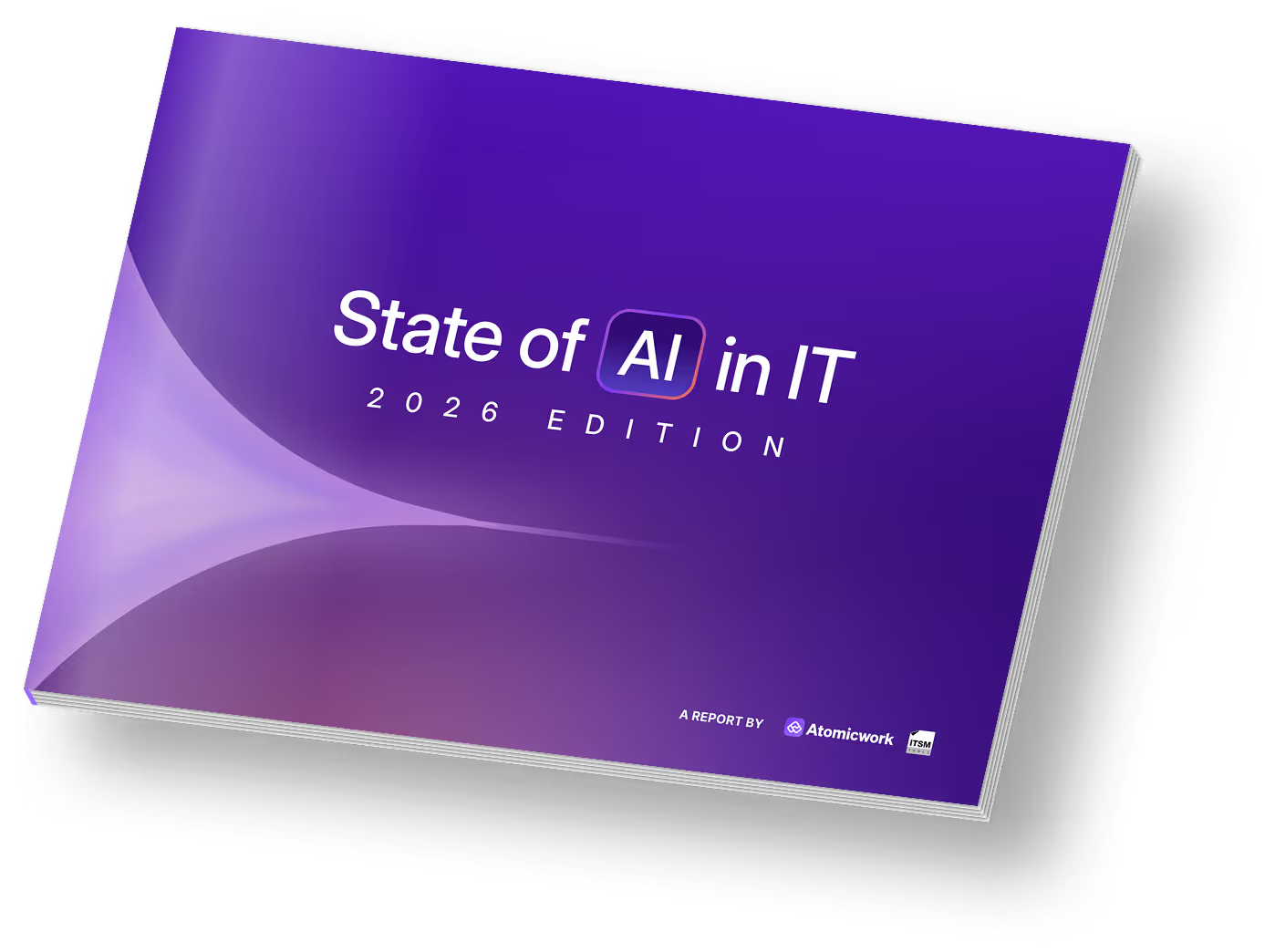15 Best Enterprise Service Management (ESM) tools for modern businesses in 2025
Doug Tedder, IT veteran and principal of Tedder Consulting, is bullish on enterprise service management (ESM) as the next frontier of AI-powered IT management, and for a good reason. Adoption of ESM strategies rose sharply from 43% in 2019 to 68% in 2021, with a projected CAGR of 14.20% through 2028. This rapid growth makes one thing crystal clear: investing in ESM is no longer an option—it’s becoming a cornerstone of delivering a world-class employee experience.
What is an enterprise service management software?
In Doug’s own words:
ESM is not about spreading ITSM practices and principles everywhere, but creating workflows across other departments that truly reflect the needs of people and processes. IT often views things from the end-user perspective, but ESM takes the bigger picture into account, ensuring all stakeholders are supported and involved. - Doug Tedder, IT veteran and principal of Tedder Consulting
The core idea behind having an enterprise service management platform for an organization is to:
- Create a single point of contact for all service requests instead of employees hunting down different departments or people.
- Standardize how services are requested and delivered from submission to resolution, with clear steps and ownership
- Prioritize, assign, and track all work items in one place with real-time updates and eliminate the need for multiple spreadsheets or email chains
- Improve visibility into team workload, work status, performance, and impediments blocking your enterprise productivity
- Automate routine tasks and approvals to reduce the time spent on repetitive work
Think of it as a digital hub where employees can request anything they need from different departments, while teams can manage and fulfill these requests systematically - similar to how IT help desks work but applied to all business services.
Read on to understand how each of these benefits can transform your team's operations, and discover the top ESM tools that can make this transformation possible.
1. Atomicwork
Atomicwork connects HR, ITSM, facilities, and finance for a unified service experience that’s smooth and powerful. Its flexible modular design fits your workflows like a glove, giving you unmatched visibility and control, made possible through agentic service management.
Key features:
- Organize enterprise services into a catalog and speed up support for incoming requests so your employees get the help they need, fast and hassle-free
- Unified employee journey right from onboarding to appraisals, and offboarding to account closures
- Automated approvals and reminders for change and access requests, device assignments, and welcoming new members
- Employee self-service from Slack and MS-teams for repetitive tasks like generating employment letters, profile updates, or password resets
- Centralized employee data and tool stack without the pain of complex integrations or maintenance.
- Atom AI—round-the-clock, work-friendly concierge that keeps your team moving forward with instant (and accurate) answers.
Ammex Corp saw a 65% faster ticket resolution, thanks to Atomicwork’s cognitive engine that learns and improves with time and resolves tasks right at the employee level without the need for agent escalations.
Unlike Jira Service Management, Atomicwork allowed us to maintain our IT service team without adding a single headcount in six months. It handles simple queries that used to interrupt our Finance team, and it provides our CEO with real-time updates on shipments and orders - questions that would normally require a phone call or an email or a meeting, disrupting someone’s day. - Chad Ghosn, CIO of Ammex Corp
2. ServiceNow
ServiceNow is a no-code workflow automation engine that allows organizations to build custom applications, map services, create automated ticket routing engines, and connect data from over 200 applications to design workflows that grow and evolve alongside your business.
Key features:
- Enterprise-wide workflow orchestration across IT, HR, and legal departments
- Native mobile app development platform with a no-code builder
- Advanced performance analytics and KPI dashboards
- Multi-cloud resource management and optimization
- Process mining and automation discovery

3. BMC Helix
BMC Helix, powered by the BMC AMI platform, operates as a cognitive automation platform designed for hybrid cloud environments. With decades of enterprise knowledge baked in, the solution auto-scales services and manages resource and asset allocation on the go across cloud and on-premises infrastructure.
Key features:
- Unified IT operations management by integrating with BMC Helix for ServiceOps and BMC HelixGPT
- Multichannel self-service AI agents
- Handles multi-cloud management across AWS, Azure, and Google Cloud with single interface
- Supports 25 different languages for global service desk operations

4. Freshservice
Freshservice brings service management and automation together with its super-efficient AI chatbot, Freddy.
Key features:
- Contextual intelligent automation to reduce ticket resolution time
- Native project management capabilities with custom project metrics
- 100+ pre-built workflow automation for common scenarios
- Software license optimization

5. Ivanti Neurons
Ivanti Neurons simplifies IT service management and endpoint security by automating everyday device fixes, tracking inventory across endpoints in real-time, and keeping your ITSM processes running smoothly.
Key features:
- Automated spend intelligence with a detailed view of the asset portfolio—including purchase records, license timelines, and contracts.
- Real-time endpoint management across 100+ devices
- Self-healing automation with in-built patch management
- Edge device discovery and monitoring
- Location-aware service catalogs and push notifications

6. ManageEngine ServiceDesk Plus
ManageEngine’s ServiceDesk Plus is a full-stack service management platform that excels in providing enterprise-grade functionality at a middle-market price point and comes with augmented analytics capabilities, and an enterprise service bus architecture.
Key features:
- Service desk data visualization through charts, summary reports, and customizable export
- Unified knowledge management, network discovery, and employee self-service
- Pre-configured SLA tracking, contract oversight, and license management

7. SysAid
SysAid takes the heavy lifting out of service management by routing tickets using historical resolution patterns and ensuring faster turnaround times.
Key features:
- AI-powered ticket routing
- Password reset automation
- 45+ industry-specific workflow templates

8. TOPdesk
TOPdesk prides itself on being a “shared service” solution built for collaboration with the visual planning board helping you master resource allocation across multiple teams.
Key features:
- Visual resource planning to account for 500+ technicians at once
- Webshop-style service catalog for request management
- Communal goals to keep your team aligned
- 100+ customizable report templates to analyze and share insights
- Interactive self-service portal and a dynamic form builder to collect feedback

9. Serviceware
Serviceware’s enterprise management platform uses a data-driven cost allocation framework to track every expense tied to service delivery, while its portfolio management tools make it easy to analyze the financial impact of changes to your services.
Key features:
- HR service management to automate hire requests, onboarding, and offboarding
- Self-service with knowledge database and survey module for better employee listening
- Financial modeling and cost allocation spanning multiple categories of service items
- Reports & dashboards for financial insights at your fingertips
- GDPR workflows to ensure all requests—no matter where they come from—are processed with full accuracy and transparency

10. IFS (Axios) Assyst
By focusing on business metrics, IFS (Axios) Assyst creates clear connections between IT services and organizational outcomes to maintain alignment between IT operations and business goals.
Key features:
- 200 service templates and a no-code visual process design for quick setup
- Dynamic SLA adjustments powered by 50+ metrics
- Business relationship management with 1,000+ stakeholders for better collaboration
- Impact analysis in real-time to measure how services affect business outcomes
- Consistent process standardization to ensure uniform service across the board

11. EasyVista
EasyVista is a cloud-based EMS with a micro-apps framework that can help you roll out self-service portals, make onboarding smoother, and simplify help desk management.
Key features:
- Service Apps Studio and AR support for faster field resolution
- Mobile-first design designed to handle thousands of service requests daily
- Knowledge delivery system with high content relevancy
- Process automation builder

12. Xurrent
If you're working with multiple service providers, Xurrent is the platform that makes everything run smoothly. With built-in support for multi-sourcing environments, it routes workflows automatically across different providers.
Key features:
- Multi-provider management across 100+ service providers
- Trust relationships management
- Provider performance tracking across 50+ metrics
- Real-time SLA and enterprise service monitoring

13. USU Service Management
USU is an enterprise service management tool that knows how to leverage AI for a user-backed experience and comes with self-regulating business service monitoring for up-to-the-minute visibility into your service performance.
Key features:
- AI-powered knowledge management to auto-categorize over thousands of articles
- License management and optimization
- Capacity management to ensure your resources are always used efficiently
- Cost allocation tracking for clear insights into departmental spending

14. Matrix42
Matrix42 unifies endpoint management, service delivery, and compliance monitoring into one powerful platform along with a customizable, self-service catalog that adapts services based on your unique role, location, and access rights of each user.
Key features:
- Digital workspace and user profile management with access controls
- Real-time policy enforcement across endpoints with self-operating risk assessment tools
- Device discovery, inventory and software distribution
- Dynamic pricing and approvals
- Usage analysis and optimization

15. Alemba Service Manager
Built around visual process management, Alemba Service Manager enables organizations to design sophisticated, no-code workflows to give you full control over service management.
Key features:
- Automated impact analysis to reduce change failures
- Project portfolio alignment
- Custom dashboards to track project-specific metrics
- Change advisory board automation

How to choose the right ESM tool for your team?
Finding the perfect ESM platform for your team can transform the way you manage workflows and deliver services. But with so many choices, how do you make the right pick? Here’s a breakdown of what to look for to ensure you choose a platform that drives enterprise efficiency and fits your team’s goals at the same time.
1. Native integrations
An ESM tool is only as good as how well it works with your existing tech stack. Think about the systems your team already depends on—HR software, project management tools, communication platforms, etc. Your ESM should sync up with these to eliminate data silos and keep things flowing smoothly.
Look for tools with pre-built integrations or open APIs, which allow your team to connect the ESM with other enterprise systems like CRM, ERP, or ITSM. Don’t overlook integration flexibility—being able to quickly plug in your existing tools will save time and reduce friction.
2. Customized workflows
Every business is different, so your ESM tool needs to be flexible enough to adapt to your workflows. Whether it's customizing forms, tailoring service catalogs, or configuring approval processes, your ESM should reflect the way your organization operates.
Take the example of a custom request process that needs approval from IT, finance and the required department head for any software procurement. Your ESM tool should allow you to create a custom workflow that routes the request through these specific steps with space for automated reminders and approvals (till a certain sum). A solution with drag-and-drop customization and rule-based automation will ensure the system adapts to you, rather than forcing you to adapt to it.
3. Reporting and analytics
Your ESM tool should give you clear, actionable insights into how your service operations are really performing. Look for advanced reporting and analytics features that track key metrics like ticket resolution times, service request volumes, MTTR, FCR, and customer satisfaction. These metrics are non-negotiable—they directly impact your product performance, so make sure they’re always in the spotlight.
A top-tier ESM platform should also allow you to create custom dashboards, pulling data from multiple sources that matter most to your team. This way, leadership gets the real-time insights they need to make informed, data-driven decisions.
4. Agentic AI for intelligent automation
Unlike traditional automation, where a single system handles everything, Agentic AI architecture enables the deployment and coordination of multiple specialized AI agents, each designed for distinct tasks and departments. With Agentic AI, your ESM becomes a scalable, efficient system that adapts as your company grows and automates tasks across departments without having to worry about data silos and cross-functional barriers.
Look for an ESM platform that allows you to deploy and manage multiple AI agents from a single dashboard across different departments. The platform should make it easy to configure, monitor, and coordinate these agents with a low code interface, and help your team work smarter, not harder, and reduce the time spent on low-value tasks.
5. Security to protect your data at all costs
Your platform needs to meet your organization’s security standards, including encryption, strict access controls, and full compliance with industry regulations like GDPR or HIPAA. Role-based access is a must—only authorized users should be able to access sensitive data or perform critical actions. It’s also crucial to evaluate how the tool manages data backup and disaster recovery. A security lapse in your service management system could threaten your entire operation—so make security non-negotiable.
Atomicwork simplifies ESM without sacrificing power. Its sleek, intuitive interface and robust automation make service management simpler than ever, and unlike clunky legacy tools, it offers intelligent workflows, a dynamic service catalog, and real-time analytics from a single dashboard. Find out how Atomicwork can improve your enterprise service delivery. Start with a quick demo.
Frequently asked questions
An enterprise service management (ESM) software is a platform that extends IT service management principles across an organization's various departments (like HR, finance, facilities, legal, etc.) to centralize service requests, standardize processes, and automate routine tasks.
While ITSM focuses on solely IT-related services, ESM expands service management to include departments like HR, marketing, and finance to create a unified digital hub where employees can request services across the enterprise and improve service delivery.
An ESM platform makes work more efficient by centralizing service requests, automating routine tasks, and improving collaboration between teams. It streamlines workflows, reduces response times, and provides real-time visibility into operations, empowering teams to deliver consistent, high-quality services while boosting employee satisfaction and driving overall business productivity.
A few common challenges to ESM evaluation include integration limitations with existing systems, a steep learning curve that hampers user adoption, and a lack of customization to fit unique workflows. Additionally, some tools may offer inadequate reporting or struggle to scale effectively as the organization grows, leading to performance issues.
More resources on modern ITSM


































%20Tools_Atomicwork%20.avif)



